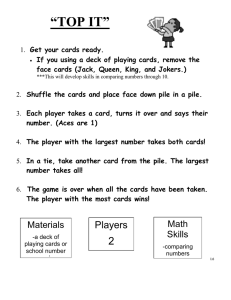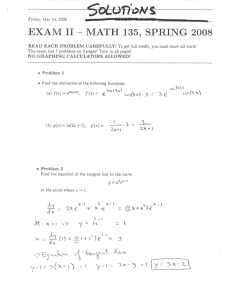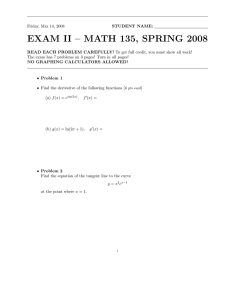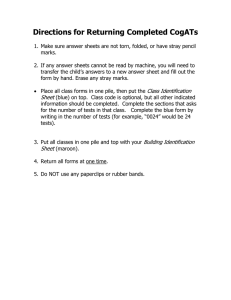Mechanism Research on the Improvement of Bearing Capacity of Single
advertisement
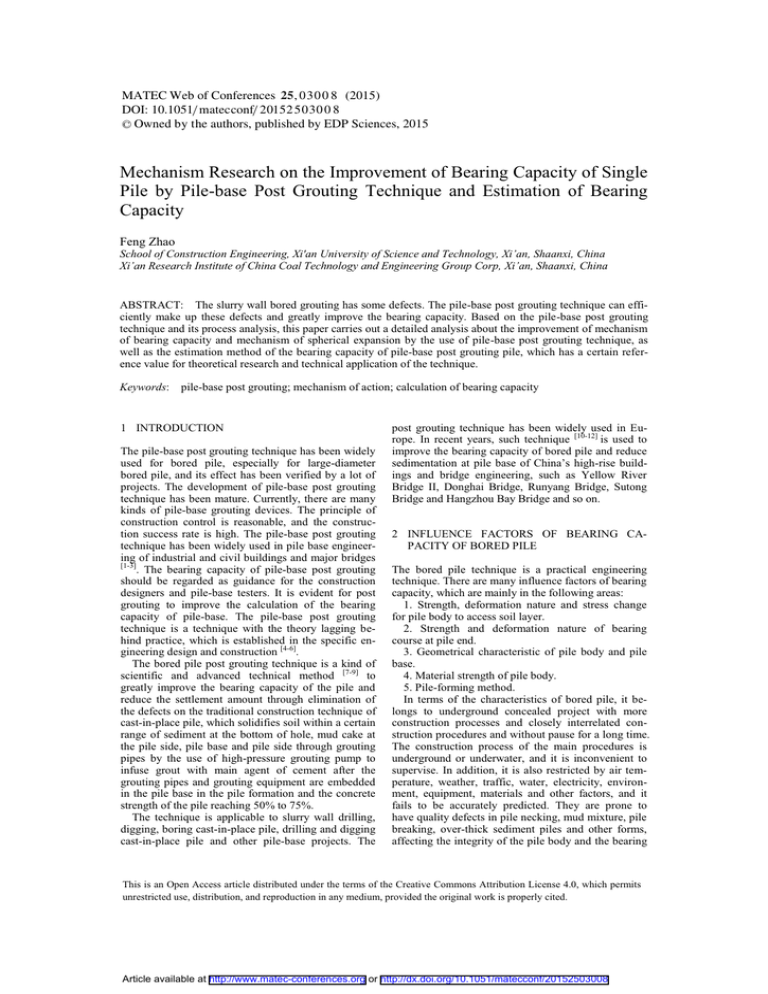
MATEC Web of Conferences 25 , 0 3 0 0 8 (2015)
DOI: 10.1051/ m atec conf/ 201 5 2 5 0 3 0 0 8
C Owned by the authors, published by EDP Sciences, 2015
Mechanism Research on the Improvement of Bearing Capacity of Single
Pile by Pile-base Post Grouting Technique and Estimation of Bearing
Capacity
Feng Zhao
School of Construction Engineering, Xi'an University of Science and Technology, Xi’an, Shaanxi, China
Xi’an Research Institute of China Coal Technology and Engineering Group Corp, Xi’an, Shaanxi, China
ABSTRACT: The slurry wall bored grouting has some defects. The pile-base post grouting technique can efficiently make up these defects and greatly improve the bearing capacity. Based on the pile-base post grouting
technique and its process analysis, this paper carries out a detailed analysis about the improvement of mechanism
of bearing capacity and mechanism of spherical expansion by the use of pile-base post grouting technique, as
well as the estimation method of the bearing capacity of pile-base post grouting pile, which has a certain reference value for theoretical research and technical application of the technique.
Keywords: pile-base post grouting; mechanism of action; calculation of bearing capacity
1 INTRODUCTION
The pile-base post grouting technique has been widely
used for bored pile, especially for large-diameter
bored pile, and its effect has been verified by a lot of
projects. The development of pile-base post grouting
technique has been mature. Currently, there are many
kinds of pile-base grouting devices. The principle of
construction control is reasonable, and the construction success rate is high. The pile-base post grouting
technique has been widely used in pile base engineering of industrial and civil buildings and major bridges
[1-3]
. The bearing capacity of pile-base post grouting
should be regarded as guidance for the construction
designers and pile-base testers. It is evident for post
grouting to improve the calculation of the bearing
capacity of pile-base. The pile-base post grouting
technique is a technique with the theory lagging behind practice, which is established in the specific engineering design and construction [4-6].
The bored pile post grouting technique is a kind of
scientific and advanced technical method [7-9] to
greatly improve the bearing capacity of the pile and
reduce the settlement amount through elimination of
the defects on the traditional construction technique of
cast-in-place pile, which solidifies soil within a certain
range of sediment at the bottom of hole, mud cake at
the pile side, pile base and pile side through grouting
pipes by the use of high-pressure grouting pump to
infuse grout with main agent of cement after the
grouting pipes and grouting equipment are embedded
in the pile base in the pile formation and the concrete
strength of the pile reaching 50% to 75%.
The technique is applicable to slurry wall drilling,
digging, boring cast-in-place pile, drilling and digging
cast-in-place pile and other pile-base projects. The
post grouting technique has been widely used in Europe. In recent years, such technique [10-12] is used to
improve the bearing capacity of bored pile and reduce
sedimentation at pile base of China’s high-rise buildings and bridge engineering, such as Yellow River
Bridge II, Donghai Bridge, Runyang Bridge, Sutong
Bridge and Hangzhou Bay Bridge and so on.
2 INFLUENCE FACTORS OF BEARING CAPACITY OF BORED PILE
The bored pile technique is a practical engineering
technique. There are many influence factors of bearing
capacity, which are mainly in the following areas:
1. Strength, deformation nature and stress change
for pile body to access soil layer.
2. Strength and deformation nature of bearing
course at pile end.
3. Geometrical characteristic of pile body and pile
base.
4. Material strength of pile body.
5. Pile-forming method.
In terms of the characteristics of bored pile, it belongs to underground concealed project with more
construction processes and closely interrelated construction procedures and without pause for a long time.
The construction process of the main procedures is
underground or underwater, and it is inconvenient to
supervise. In addition, it is also restricted by air temperature, weather, traffic, water, electricity, environment, equipment, materials and other factors, and it
fails to be accurately predicted. They are prone to
have quality defects in pile necking, mud mixture, pile
breaking, over-thick sediment piles and other forms,
affecting the integrity of the pile body and the bearing
4
!
Article available at http://www.matec-conferences.org or http://dx.doi.org/10.1051/matecconf/20152503008
MATEC Web of Conferences
capacity of single pile, especially the slurry wall
cast-in-place pile. The over-large consistency may
form “mud cake” on the surface of pile side to greatly
reduce the frictional resistance, while the over-thick
sediment at the bottom of hole will obviously decrease
the end resistance [13].
How to improve the side resistance and end resistance of bored pile is a research subject urgently
required to be addressed in the engineering practice.
The pile end and pile side post grouting technique is
one of effective measures to improve the bearing capacity of cast-in-place pile. This paper focuses on
illustration of the mechanism, technique and application effect of bored pile-base post grouting at medium-coarse sand layer of the bearing course at pile end
combined with engineering practice. As we all know,
in the bored pile construction at medium-coarse sand
layer, there are difficulties in cleaning slag and reduction of bearing capacity at pile end by disturbance of
medium-coarse sand layer. The pile-base post grouting
technique effectively reinforces the medium-coarse
sand layer, thereby improving the bearing capacity of
pile. Meanwhile, it also greatly reduces the deformation of single pile and the differential settlement of
pile groups due to reinforcement of pile end and surrounding soil.
This paper proposes a principle of design calculation through analysis about influence factors of bearing capacity of bored pile and the mechanism of improving the bearing capacity of single pile by bored
pile post grouting.
3 OVERVIEW OF PILE-BASE POST GROUTING
TECHNIQUE AND TECHNIQUE CLASSIFICATION
3.1 Overview of pile-base post grouting technique
fied grout (such as neat cement slurry, cement mortar,
cement paste with admixture, chemical grout and so
on) in penetration, filling, replacement, cleaving, consolidation, solidification and other physical or chemical forms through the grouting pipe embedded in the
pile body and pressing into the pile end with a certain
pressure and an enlarged head at pile base after formation of bored pile. Schematic diagram of pile-base
post grouting effect is shown in Figure 1.
3.2 Technique classification
Based on the grouting technique, pile end pressure
grouting can be divided into two categories: the open
grouting and the closed grouting.
The open grouting means that the grout is directly
injected into pile end through embedded grouting pipe,
and respectively mixed with sediment at pile base and
surrounding soil at pile end, so as to form an effect of
the composite foundation at pile end; The closed
grouting means that the grout is injected into a prefabricated cavity with a good elasticity, and the elastic
cavity will gradually swell and expand with the increase of grouting pressure and grouting amount,
forming grout bubble in a lower soil layer at pile end,
and the generation and gradual expansion of the grout
bubble will be bound to produce a compaction effect
on the soil layer at pile end [14-16].
Obviously, the growing rate of bearing capacity of
single pile is relatively stable to use the closed grouting. Especially when the pile end is a sand layer, the
effect is better. However, the construction process of
closed grouting is more complicated, while the improvement of bearing capacity of open grouting is
inferior to that of the former, but its construction process is relatively simple, so it is widely-used.
The bored pile-base post grouting technique herein
is an open grouting technique of the embedded grouting pipe on pile body.
4 MECHANISM OF IMPROVING BEARING
CAPACITY BY PILE-BASE POST GROUTING
Figure 1. Schematic diagram of pile-base post grouting effect
The pile-base post grouting refers to a project’s technical measure that can improve the resistance at pile
end and pile side to different degrees, reduce pile
sedimentation and significantly improve the bearing
capacity of pile through physical and mechanical
properties’ changes of soil at pile end and surrounding
pile side by individual and combined action of solidi-
1) The grout infiltration rate of grouting is high in
bearing course at pile end of the coarse-grained soils
(medium sand with a greater porosity, coarse sand,
pebble, gravel). The grout can greatly improve the
disturbance of the bearing course and strength and
deformation modulus of the bearing course that mainly through penetration, part of compaction, filling and
consolidation effects, and form an enlarged head to
increase the stressed area of pile end and improve the
resistance of pile end.
In order to implement the permeability grouting, we
assume that the stratum structure is substantially free
of disturbance and destruction, and can overcome
various obstacles of grout flow and penetrate into
holes or fractures in the stratum under grouting pressure. The holes should be filled by penetration and
filling methods. After the solidification of grout, soil
03008-p.2
EMME 2015
particles are bonded together to form cement-soil
stone body, which can greatly improve the disturbance
of the bearing course and strength and deformation
modulus of the bearing course, and form an enlarged
head to increase stressed area of pile end. Thus the
growing rate of bearing capacity is large.
Influence factors of grout diffusion range are holes
or fractures in the stratum (or permeability coefficient),
grout viscosity, grouting pressure and grouting time
and so on.
2) The grout infiltration rate of grouting is low in
bearing course at pile end of the fine-grained soils
(cohesive soil, silty soil, silt, fine sand and so on), thus
achieving the fracture grouting. The so-called fracture
grouting means that under the grouting pressure, the
grout overcomes the initial stress and tensile strength
of the stratum, causing destruction and disturbance of
soil structure, and making it fracture along the plane
perpendicular to the stress, so that the original fractures or holes in the stratum open to form new fractures or holes, and the grout permeates into the stratum along the fracture vein, so the groutability and
diffusion length of the grout increase. Under the state of fracture grouting, the failure in the
increase of bearing capacity of grouting pile at pile
end is due to the existence of fracture grout vein. The
single medium of soil body is segmented and reinforced by mesh stone body as composite soil body, so
as to improve the density of pile end soil body and
effectively transfer and share the load, thereby improving the resistance at pile end [17-18].
With the comparison of grout infiltration rate, the
rate of fracture grouting mode is smaller than that of
permeability grouting. Therefore, the growing rate of
ultimate bearing capacity of pile end grouting pile of
the former is much smaller than that of the latter.
3) The pile end sediment and injected grout has
physical and chemical reaction and solidification,
condensing into a stone body with a new structure,
high strength, and stable chemical property, so as to
enhance the resistance at pile end.
4) With the increase of grouting amount and grouting pressure, the cement grout continuously penetrates
into the bearing course at pile end due to immersion
by mud and becoming soft, thus forming aploid at pile
end. When the aploid enlarges continuously, the infiltration capacity is restricted by surrounding dense soil,
so the pressure continues to rise. The pressure increases play a role of compaction in the bearing course
at pile end, thus improving the bearing capacity of pile
end soil body. Meanwhile, the aploid is formed at pile
end, so the bearing area at pile end increases, and it is
equivalent to expanding base for the bored pile,
thereby increasing the resistance of slurry wall bored
pile at pile end.
5) When grouting in the bearing course at pile end
of weathered bedrock with the medium or above impermeability, in case of not enough grouting pressure,
due to the constraints of surrounding rock, the pressure grout can only be penetrated or filled in sediment,
forming grout bubble to extrude surrounding sediment
particles, so that the mud filling among sediments
produces dehydration and consolidation; in case of
enough grouting pressure, it will produce fracture
grouting and compaction effects.
6) When the grouting pressure increases and the
grouting amount continuously increases, the grout
injected into the pile end may penetrate under pressure
along the mud cake among pile soil within a certain
height range above the pile end, reinforce the mud
cake, fill in gap of the pile body and soil body around
pile, and penetrate into a certain width of soil layer
around pile. After solidification of grout, a wider
range of soil body around pile is mobilized to participate in the pile bearing, so as to increase the pile side
friction.
7) For pressure grouting at pile end, when the infiltration capacity at pile end is restricted, the grout
pressure of sploid will increase continuously. Under
the effect of high-pressure liquid, it may impose upward reverse prestress on the pile end face, and
slightly lift up the pile body. When the slurry wall
bored pile bears downward vertical load, the reverse
prestress will bear partial load, thereby increasing the
bearing capacity of pile end.
8) Under the effect of grouting pressure, the compressive deformation at pile end is partially completed
ahead of schedule during the construction period, so as
to reduce the vertical compressive deformation in the
later period of use.
5 CALCULATION OF SPHERICAL EXPANSION
THEORY OF PILE END POST GROUTING
The spherical expansion theory of pile end post grouting is used for interpretation of representative theory
of permeability grouting in the foundation of above
the medium sand. The calculation model of spherical
expansion theory is shown in Figure 2. The calculation
is used to assume:
Figure 2. Schematic diagram of grout spherical expansion at
the bottom of grouting pipe
03008-p.3
MATEC Web of Conferences
(1) The grouting sand is homogeneous and homodromous.
(2) The grout is Newtonian fluid, which is generally
in line with Newton’s law of friction, that is, the linear
relationship between the shear stress and the shear
deformation speed is called Newtonian fluid.
(3) The grout is injected into foundation soil from
the bottom of grouting pipe.
(4) The grout presents a spherical expansion in the
stratum.
The grout expansion radius at pile end can be calculated by such assumptions. In the process of grouting, assuming that the grout infiltration is in line with
Darcy’s Law:
Q kgiAt 4kgir 3t
i
(1)
dh
dr
Substitute into (1): Q
4
k
Through the above integration,
r 2 t
dh
dr
Q
h C (2)
4ktr
When r=r0, h=h0
r=r1, h=h1
Substitute into (2) Formula,
h0-h1=
6 ESTIMATION METHOD OF BEARING CAPACITY OF PILE END GROUTING PILE
Q 1 1
( )
4kt r0 r1
(3)
Assuming that the filling rate of grout is , then
4
3
Q dr1 n
3
(4)
Substitute Formula (4) into Formula (3):
r1 n 1 1
( )
3kt r0 r1
3
h0-h1=
So:
h =
r1 n 1 1
( )
3kt r0 r1
(5)
3
When r0»r1, so r1=
3ktr0 h
Q is the grouting amount;
kg is the permeability coefficient of grout in the
stratum, kg = k / β;
β is the ratio of grout viscosity to water viscosity.
Assume that the grouting process is constant;
A is the permeability area;
rˍis the radius of grout diffuser;
h1 is the water pressure head at the edge of grout
diffuser;
h0 is the grout pressure head at the grouting nozzle;
H is a sum of underground water head at the grouting nozzle and grouting pressure;
r0 is the radius of grouting pipe;
t is the grouting time;
n is the soil porosity.
As can be seen from the Formula (7), the solid size
increases with the increase of the permeability coefficient of soil (k) and the grouting head difference at the
exit (Δϴ), and it decreases with the increase of filling
rate (α), soil porosity (n) and grout viscosity. In addition, the permeability coefficient of soil decreases
with the increase of filling rate (α). The compaction
and fracture grouting should also involve in soil
strength, stress-strain relationship and changes in the
grouting process [19-25].
Therefore, the reinforcement range could not expand with the increase of time, which only indicates
that the achievement of a certain reinforcement range
requires adequate grouting time.
(6)
(7)
Where:
k is the permeability coefficient of soil and assume
that the grouting process is constant;
6.1 Problems in specifications
According to the specifications of Article 5.2.8 and
Article5.2.9 in Technical Specifications for Pile
Foundation (JGJ94-94), the standard value of vertical
ultimate bearing capacity of single pile of slurry wall
bored pile can be calculated by the Formula (5.2.8).
Where: qsik takes the value according to Table 5.2.8-1
in the specification; qpk takes the value according to
Table 5.2.8-1 in the specification. When the pile diameter d≥800mm, there is a need to introduce two
large-diameter piles side resistance and coefficient of
pile end size effect of ψsi and ψp, and take value according to 5.2.9-2 in the specification.
Quk Qsk Q pk u si qsik l si p q pk Ap
This method mainly considers the improvement of
vertical bearing capacity of single pile, which is
mainly reflected in the end bearing. The first is the
increase of intensity of pile end soil and elimination of
sediment, and the second is expansion of stressed area
at pile end without considering the increase of side
resistance. Therefore, this method considers that the
pile diameter after grouting should be calculated by
the pile diameter designed originally. qsik takes value
according to Table 5.2.8-1 in JGJ94-94, while the end
03008-p.4
EMME 2015
Table 1. Composite value (qpk) of ultimate end resistance of pile end grouting pile
Buried depth of slurry wall bored pile ( h /m)
Name of soil
Status of soil
h≤9
9< h ≤16
16< h ≤30
h >30
Sandy sticky clay
Residual soil,
strong weathered rock
ridge
Grouting
times
0.25<IL≤0.5
1200~1800
1800~2400
2400~2900
2900~3500
1
0<IL≤0.25
2200~2900
2900~3700
3700~4500
4500~5300
1
0<IL≤0.25
e≤0.75
Slightly dense, medium dense, dense
650~1300
1200~1800
650~1300
1200~1800
1300~1600
1800~2400
1300~1700
1800~2550
1600~2000
2400~2800
1700~2000
2550~3000
2000~2550
2800~3500
2000~2400
3000~3800
1
1
1
1
Fine sand, medium
sand, coarse sand
Medium dense, dense
2000~3300
3000~5000
5000~7000
3300~4000
5000~6000
7000~8000
4000~4700
6000~6500
8000~9000
4700~5500
6500~7000
8500~9000
2
2
2
Gravel sand, dust,
pebble, gravel, scree,
strong weathered rock
ridge, gravelly soil
Medium dense, dense
6000~9000
7000~10000
8000~11000
Silty soil
Silt
resistance qpk adopts a composite value to adjust the
vertical bearing capacity of single pile.
6.2 Calculation based on the adjustment value of side
resistance after grouting
To adjust the standard value of total ultimate side
resistance of pile end grouting pile:
qpk takes value according to Table 2. qpk refers to
Table 2. Table 2 is a composite value of q pk after adjustment according to the test results. For a
large-diameter pile (d≥800mm), the size effect coefficient takes value according to Table 5.2.9-2 in
JGJ94-94.
6.3 Calculaiton formula of ultimate bearing capacity
of single post grouting pile
Consider the problem of diameter expansion of grouting
1) Calculation of pile diameter (r’) at the expansion
of pile body
r’˙{ǒH grout/(ρgrout·C grout)Ǔ/(L·π)ˇr2}1/2
Where:
H grout is the grouting amount;
ρ grout is the grout density;
C grout is the grout stone rate;
L is the pile length at the expansion of pile (a sum
of pile length of non-clay layer);
r is the radius of bored pile (pile radius of
non-expansion place);
2) Standard value of vertical ultimate bearing capacity of single post grouting pile (Quk):
Quk˙QskˇQ’pkˇQpk˙u∑qsikliˇq’pjkA’pjˇqpkAp
Where: Qsk is the standard value of total ultimate
bearing capacity of pile side;
Q’pk is the standard value of total ultimate side resistance at the place of expansion of pile;
2
2
2
Qpk is the standard value of total ultimate side resistance at pile end;
u is the perimeter of pile body, and the diameter
expansion is 2πr’·lj, the non-diameter-expansion is
2πr·li;
qsik is the standard value of ultimate side resistance
at the ith layer of soil at pile side (take value according
to the underwater bored pile in Table 5.2.8-1 of the
Specification);
li is the thickness at the ith layer of soil;
q’pjk is the standard value of ultimate side resistance
at the jth expansion of pile body (take value according
to the operating bored pile in Table 5.2.8-1 of the
Specification);
A’pj is the expansion area at the jth expansion of pile
body, A’pj˙π·˄r’2ˉr2˅;
qpk is the standard value of ultimate side resistance
at pile end (take value according to operating grouting
pile in Table 5.2.8-1 of the Specification);
Ap is the sectional area at pile end.
7 CONCLUSION
1) Through pile-base post grouting treatment, the
slurry wall bored pile can effectively deal with sediment at pile base, eliminate hidden dangers at pile
base, reduce the discreteness of vertical bearing capacity of the pile foundation and differential settlement, so as to ensure the quality stability of the pile
foundation.
2) Through pile-base post grouting treatment, the
vertical bearing capacity of single pile can be calculated by the numerical values provided herein, but it
should be determined through engineering static load
test. Due to the complexity of pile end pressure grouting, calculation of pile end pressure grouting pile is
not mature enough. The current calculation method of
the bearing capacity of grouting pile is only applied to
short small and medium diameter pile in the construc-
03008-p.5
MATEC Web of Conferences
tion sector.
3) After the pile end grouting, the pile side resistance and pile end resistance has been improved to
varying degrees. How to analyze and summarize the
distribution rules of bearing characteristics of bored
pile after grouting and pile side friction and end resistance through a large number of data on the static
load test and stress-strain test of test pile should be our
future research directions.
4) The impact of pile end post grouting on the pile
group effect and how to consider the pile group effect
in design requires an in-depth research and analysis.
REFERENCES
[1] Zhang Chunfeng, Wang Xiao, & Yao Wenjuan. 2015.
Research on post grouting super-long pile test and ultimate bearing capacity. Construction Technique, 07:
63-67 + 71.
[2] Deng Xianghui, Zhang Yongjie, & Fang Haibo. 2015.
Analysis and experimental research on the bearing capacity of post grouting bored pile. Journal of Architecture Science and Engineering, 02: 58-64.
[3] Wang Gang, & Li A’lei. 2014. Experimental research on
the bearing capacity of cast-in-place pile post grouting.
Highway and Transportation Research (Applied Technique), 06: 262-264.
[4] Wang Bin, Zhu Jintai, & Xu Zhongwen. 2013. Application of slurry wall bored pile post grouting technique.
Building Technique Development, 02: 46 - 47 + 60.
[5] Wang Zhongfu, Liu Handong, He Siming, & Huang
Zhiquan. 2013. Experimental research on the load of
vertical bearing characteristics of post grouting super-long cast-in-place pile. Journal of Underground
Space and Engineering, 02: 253 - 257 + 262.
[6] Tian Xuefei, Lu Haijun, Yan Jingxia, Chu Chengfu, Lu
Lihao, & Dong Mansheng. 2013. Comparative research
on the calculation method of bearing capacity of post
grouting pile foundation. Journal of Geotechnical Engineering, S1: 372-377.
[7] Wu Yizhang. 2013. Experimental research on the bearing capacity of post grouting cast-in-place piles in silt
region. Building Science, 07: 66-70.
[8] Liu Jinli, & Zhu Jingcheng. 1996. Technique and its
application of slurry wall cast-in-place pile post grouting, Building Foundation Institute of China Academy of
Building Research.
[9] Li Shijing, Liu Xiaomin, & Yang Jianlin, 1990.Bored
pile construction technique, Beijing, Geological Publishing House.
[10] Chen Xiaoming, & Lin Shan. 1999. Post grouting technique of slurry wall cast-in-place pile-base and estimation method of vertical bearing capacity of single pile,
Exploration Engineering, (3).
[11] Ye Shulin, et al. 1998. Foundation treatment manual,
Beijing, China building industry press.
[12] Wang Zhihui, Liu Bin, & Zhuang PingHui. 2002. Bearing character test of large-diameter pile-end pressure
grouting pile. Journal of Northeastern University, (02).
[13] Hu Qingli, & Zhang Kexu. 2002, Finite element analysis
of pile-base grouting pile under axial load effect. Journal
of Harbin Building University, (01).
[14] Huang Shenggen, Zhang Xiaohui, & Cao Hui. 2004.
Research on the load transfer mechanism of post grouting bored piles. Rock and Soil Mechanics, (02).
[15] Feng Dingbo. 2009. Analysis of the mechanism of
pile-end post grouting on the improvement of bearing
capacity of bored piles. Chinese and Overseas Architecture, (6).
[16] Wang Baode, 2005. Application of pile-base post grouting technique. Tianjin Construction Science and Technique, (01).
[17] Liu Tao, & Sun Xuexian. 2008. Discussion of the impact
of side resistance changes of pile-base post grouting
bored piles on vertical bearing capacity. Communications Standardization, (05).
[18] Liu Tao, & Sun Xuexian. 2008. Discussion of the impact
of side resistance changes of pile-base post grouting
bored piles on vertical bearing capacity. Communications Standardization, (05).
[19] Li Wenzhou. 2012. Calculation of bearing capacity of
static-pressure prestressed pipe pile post grouting in silt
region. Construction Technique, 05: 95-99.
[20] Jiang Yunfeng, & Wang Xinyang. 2012. Discussion of
cast-in-place pile post grouting technique. Highway and
Transportation Research (Applied Technique), 11:
264-266.
[21] Yu Zhihua, Liu Yanyan, Song Jian, Rong Xiaoyang, &
Cui Wenyan. 2011. Bored pile end post grouting technique and engineering application. Journal of Water Resources and Architectural Engineering, 03: 40-43.
[22] Xu Jun. 2011. Application of bored pile-base post
grouting technique in high-rise buildings with soft foundation. Journal of Ningbo University (Science and Engineering), 03: 67-70.
[23] Bu Anhui. 2011. Application of pile-base post grouting
technique in pile-base construction of high-rise buildings. Chinese and Overseas Architecture, 06: 150-151.
[24] Chu Chengfu, Li Xiaochun, Lu Lihao, & Xi Peisheng.
2011. Research on bearing capacity of pile-base grouting
under super-long and large-diameter bored pile in
non-cohesive land area. Journal of Geotechnical Engineering, S2: 388 -391.
[25] Liu Dapeng, Wang Guihe, & Wei Liangliang. 2011.
Application of post grouting spinning bored pile in
Tangshan area. Construction Technique, S2: 69-71.
03008-p.6


